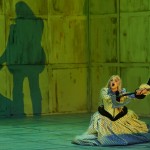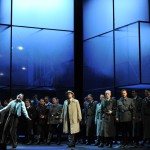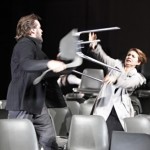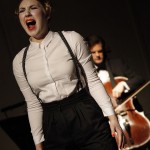
By Rebecca Schmid
In the final scene of Bach’s St. John Passion, staged by Peter Sellars at the Philharmonie on Feb.27, the members of the Rundfunkchor gather in meditation around a spotlight, the rest of the hall submerged in darkness. The body of Jesus has been quietly removed during a lament of Mary Magdalene, his absence hovering in the afterglow. With only ten arias, St. John, J.S. Bach’s first completed Passion, finds its dramatic backbone in choral numbers illustrating both the adulation and persecution that accompanied Jesus’ final days before crucifixion. The chorus can transform from a blood-thirsty mob to a gathering of pleading individuals within one scene.
Sellars relies heavily on pantomime to illustrate their very human plight. The singers, at first lying like corpses, stretch their arms to the heavens during the opening “Herr, unser Herrscher” (Lord, our Lord), only to throw dice at the dying Jesus during “Lasset uns nicht zerteilen” (Let us not be divided). Although it is sometimes a challenge to take the chorus’ histrionic expressions seriously, the director manages to capture the ambiguity, hypocrisy, cruelty and spiritual deliverance of the Gospel while always working within the space of Bach’s transcendent score. The Rundfunkchor, singing its parts from memory, immerses itself completely in the interaction of music and gesture.
Sellars considers his recreations of the Passions not stagings but ritualizations. His 2010 production of St. Matthew with the Berlin Philharmonic and Rundfunkchor was such a success that the ensembles re-joined in St. John with all the same soloists save for the now-retired Thomas Quasthoff, here replaced by baritone Roderick Williams in the role of Jesus. The director opts for an even more raw approach in St. John to externalize the music’s fierce dramatic conflict. As he explained in a recent interview via Skype (see A Hall That Invites the Audience Into the Music-Making), while “Matthew” is filled with “contemplative spaciousness, “John” is “super immediate, super visceral and shockingly realistic, over and over again.”
While chorus and orchestra interwove like polyphony in the more generously scored St. Matthew, with a white tombstone representing Jesus’ ultimate fate, St. John is all flesh and blood, violence and stasis. In one of the most powerful moments, during Pilatus’ aria urging the chorus to make a pilgrimage to the site of Jesus’ crucifixion, the chorus shouts back “where to?” from all corners of the geometric, vertiginous Philharmonie. Even the stage hands, dressed in black like the choral members and musicians, are treated as a homogenous part of the action, blurring the boundaries between theater and life, religion and secularity.
As in St. Matthew, the tenor Mark Padmore grounded the performance with a portrayal of the Evangelist at once dramatically earnest and naturalist. Often seated at the edge of the stage, he narrated with a sense of clairvoyant regret. Extensive recitatives never grew dry due to Padmore’s clear, expressive timbre, impeccable diction and direct engagement with the audience. In the role of Pilatus, Christian Gerhaher was cast as an impotent bureaucrat of sorts, sitting centerstage in empty contemplation that sometimes bordered on the deranged. Yet he brought unaffected, baritonal purity to the aria “Mein teuer Heiland” (My beloved Savior), an intimate dialogue with cello continuo and choral accompaniment that is one of the most memorable numbers in St. John.
Magdalena Kožená, returning as a Mary Magdalene figure—but this time pregnant and in a lipstick red dress—also made the most of her few numbers, conveying quiet devastation in the aria “Es ist vollbracht” (The act is completed) with a velvety, rich tone and clear diction against viola da gamba and continuo. The soprano Camilla Tilling, although blessed with a creamy timbre and commanding presence, was not as well suited to the demands of Bach’s sinuous lines, sounding thin in the extended high notes of “Zerfließe, mein Herze” (Dissolve, my heart) as she wandered among of blanket of collapsed bodies.
The tenor Topi Lehtipuu is also not the ideal choice for baroque music, with a fast vibrato that weakened his arias. Williams, when not bound to the stage floor as the blind-folded Jesus, invested his lines with pain and spiritual depth. Sir Simon Rattle and a 13-strong ensemble struck a balance between introspection and charged energy that was well in keeping with the directorial conception.
MusicAeterna
Sellars received an unexpected homage earlier this month with the arrival of Teodor Currentzis and MusicAeterna. The ensemble brought an ambitious enough program on Feb.16, performing Handel’s Dixit Dominus alongside the Purcell opera Dido and Aeneas. But the young Greek conductor returned to the half-lit Philharmonie and announced that, with Sellars in the hall, the ensemble chorus would like to perform a ritual of sorts. The chorus moved through a sequence of expressive gestures in a number from Purcell’s Indian Queen, which the director staged for MusicAeterna last year in its home city of Perm.
While the classical music world has its pick of superb early music ensembles, from Concentus Musicus to Les Arts Florissants, the origins of MusicAeterna have a stake to originality. Currentzis assembled the ensemble himself in Novosibirsk, Siberia and managed to integrate both the chorus and ensemble into the Perm Opera—over 1,000 kilometers east of Moscow—upon becoming artistic director. The musicians’ non-bureaucratic genesis is still evident in their playing. The energy is high and fresh, if at times bordering on frenetic, and the communication so easy that the players breathe with Currentzis. Phrasing unfurls in shooting but clean lines, betraying hours of intense rehearsal.
This was particularly evident in the fugal seventh movement of Dixit Dominus. In the penultimate “De torrente in via bibet,” the strings’ gripping tension recalled the finest early music ensembles, although the choral soloists did not rise to the same standards. As a unit, however, the vocal ensemble produces an even, musical glow. Even if diction was an issue in the English-language libretto of Dido and Aeneas, the performance’s charm distracted from such details. Sopranos Anna Prohaska and Nurial Rial gave magnetic performances as Dido and Belinda, and Currentzis’ fluid, lanky gestures maintained a perpetual sense of momentum and dramatic intensity.
While dynamic architecture often pushed the boundaries of authentic performance practice, the sense of understatement in the final scene could not have been more effective. Against Prohaska’s florid ornamentation in reprises of “Thy hand, Belinda,” the orchestra’s sustained pianissimo hovered on the edge of an abyss.
For more by Rebecca Schmid, visit rebeccaschmid.info

![Aikin_Laura-Konzert_ef44b706a9_93367a59a3[1]](http://www.musicalamerica.com/mablogs/wp-content/uploads/2014/03/Aikin_Laura-Konzert_ef44b706a9_93367a59a31-150x150.png)

![TOM1848[1]](http://www.musicalamerica.com/mablogs/wp-content/uploads/2014/01/TOM18481.jpg)

![Taiwan_NSO_1[1]](http://www.musicalamerica.com/mablogs/wp-content/uploads/2013/11/Taiwan_NSO_11-150x150.jpg)


